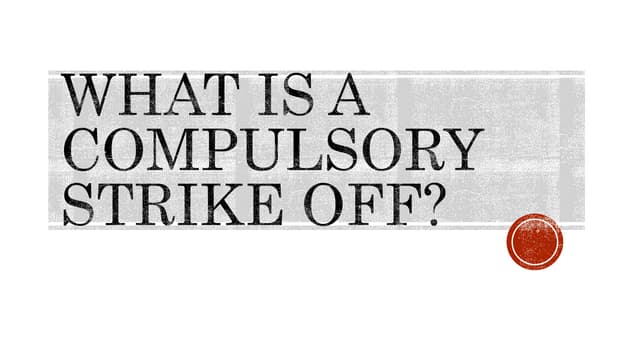Secret Considerations Concerning Compulsory Strike Off and the First Gazette Notice
Secret Considerations Concerning Compulsory Strike Off and the First Gazette Notice
Blog Article
A Comprehensive Guide to the Compulsory Strike Off Procedure in Corporate Administration
The mandatory strike off treatment, a crucial component in business administration, offers as a system to impose conformity and keep the stability of the company setting. As organizations develop and scenarios change, the need to strike off a business may arise for different reasons.

Reasons for Compulsory Strike Off
What scenarios cause the necessity of a compulsory strike off in company administration? There are numerous crucial reasons that might motivate the initiation of a mandatory strike off treatment for a firm. One typical situation is when a company stops working to comply with its statutory obligations, such as sending yearly returns or monetary declarations to the appropriate authorities. Non-compliance with governing requirements can raise worries about the company's operations and economic wellness, resulting in the decision to strike off the firm from the register.
Furthermore, companies that have actually ceased trading or are no more executing any kind of company tasks might also face mandatory strike off. This might be due to insolvency, mergings, or simply a choice to end up the firm. In such cases, maintaining the company on the register would certainly offer no purpose and might possibly produce complication amongst stakeholders.
Eventually, the requirement of a required strike off in business administration occurs when a business is no much longer operating based on the law or has actually come to be obsolete, necessitating its elimination from the official documents.
Lawful Implications and Threats
Offered the situations that motivate a compulsory strike off in company administration, it is critical to comprehend the legal implications and dangers related to such activities. When a firm is struck off the official register, it disappears as a lawful entity. This can have major effects for shareholders, supervisors, and creditors. Supervisors may face personal liability for firm financial debts incurred after the dissolution, exposing their assets to prospective seizure. Shareholders lose their investment in the firm, and lenders may find it challenging to recuperate financial obligations owed to them.
Additionally, there are lawful repercussions for people associated with the management of a company that has been forcibly struck off. They might be invalidated from acting as supervisors in the future, face penalties, or perhaps jail time if transgression or illegal tasks are revealed. Additionally, the reputational damages from a required strike off can have long-term effects on people and their capacity to take part in future business ventures. Recognizing these legal implications and threats is essential for all stakeholders associated with the corporate governance process to make sure and navigate possible mistakes conformity with the law.
Action In the Strike Off Process
Launching the obligatory strike off procedure in company administration entails a collection of prescribed steps laid out by governing authorities. The initial step commonly needs the firm to submit a formal application or notification to the relevant federal government firm or registrar signaling its intent to be struck off the main register. Subsequently, the business is typically required to clear up any impressive obligations, financial debts, or tax obligations to make certain compliance with regulatory needs.
When the initial paperwork is sent and financial responsibilities are fulfilled, the regulatory body will publish a notice in the main gazette or a comparable magazine to read what he said notify stakeholders concerning the upcoming strike off - first gazette notice for compulsory strike off. This notification acts as a last chance for any kind of interested events to increase objections or existing legitimate reasons that the firm must not be dissolved
Adhering to the publication of the notice, the regulatory authority will wage the strike off procedure if no considerable arguments or challenges occur. The company will then be formally liquified, and its name will be eliminated from the register, efficiently marking the conclusion of the compulsory strike off treatment in business administration.
Papers Required for Strike Off
In compliance with regulative guidelines, particular paperwork has to be supplied to promote the strike off procedure in business governance. The needed documents usually include a formal application for strike off, try this out which requires to be completed properly and sent to the relevant regulative authority. Furthermore, monetary declarations, such as the company's latest equilibrium sheet, need to be consisted of to guarantee that all financial responsibilities have actually been cleared up prior to launching the strike off procedure. Furthermore, a declaration of solvency or a declaration confirming that the business has no exceptional obligations is usually mandated to demonstrate that the entity can be liquified without causing damage to its lenders. Moreover, any needed authorizations from shareholders or board members need to be recorded and enclosed with the application. It is important to make certain that all the requisite paperwork is carefully ready and submitted based on the recommended guidelines to quicken the strike off process successfully. Failing to supply the needed documents might cause hold-ups or complications in the dissolution of the business.
Post-Strike Off Considerations and commitments
Following the conclusion of the essential documentation for strike off, interest shifts to the post-strike off obligations and considerations that are necessary in the corporate governance process. As soon as a firm has been struck off the register, it is vital to make certain that all continuing to be assets are dealt with suitably.

Conclusion
Finally, the obligatory strike off procedure in company administration functions as an essential device to remove defunct business from the here register. Comprehending the reasons, legal implications, actions, and files required for strike off is critical for compliance with regulatory needs. It is necessary for business to meet their post-strike off obligations and think about the effects of this procedure in order to preserve great standing and prevent possible dangers.
There are several vital reasons that might trigger the initiation of a mandatory strike off procedure for a firm (compulsory strike off). Non-compliance with regulatory needs can raise problems concerning the company's procedures and financial wellness, leading to the decision to strike off the company from the register
Report this page